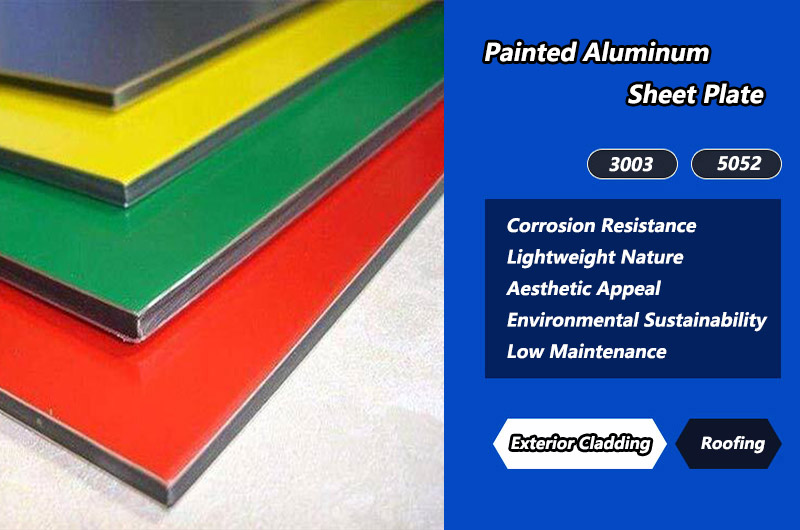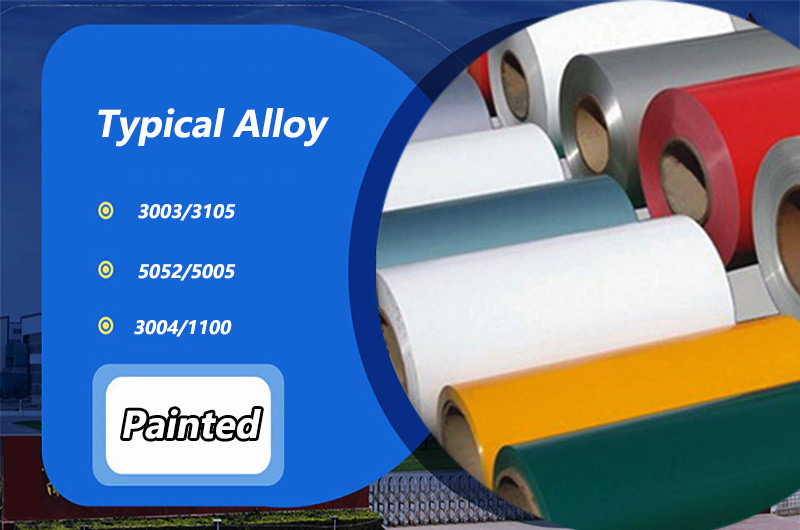- Understanding Painted Aluminum Sheet Plate
- Advantages of Painted Aluminum Sheet Plate
- What are the Commonly used Alloys Uused for Painted Aluminum Sheet Plate?
- Applications of Painted Aluminum Sheet Plate
- Related search about Painted Aluminium
- People also Ask about Painted Aluminium
- Challenges and Considerations
- Future Trends and Innovations
- Conclusion
In the world of construction, architecture, and manufacturing, materials play a crucial role in determining the success and longevity of a project. One material that has gained significant popularity due to its versatility and durability is painted aluminum sheet plate.
This article will delve into the various aspects of painted aluminum sheet plate, exploring its composition, manufacturing process, applications, and the numerous advantages it offers.

Understanding Painted Aluminum Sheet Plate
A. Composition of Painted Aluminum
Painted aluminum sheet plate is typically made from a high-strength aluminum alloy, known for its lightweight yet sturdy properties. The alloy is carefully chosen to ensure a balance between strength and malleability, making it suitable for a wide range of applications.
The surface of the aluminum sheet is coated with a layer of paint, providing both aesthetic appeal and enhanced protection against environmental factors.
B. Manufacturing Process
- Pre-treatment: Before the application of paint, the aluminum surface undergoes a thorough pre-treatment process. This involves cleaning, degreasing, and often etching to create a surface that is conducive to paint adhesion.
- Primer Application: A primer is applied to the pre-treated surface to enhance the bonding between the aluminum and the paint. This step is crucial for ensuring long-lasting and effective protection.
- Paint Application: The choice of paint can vary based on the intended use of the aluminum sheet. Common paints include polyester, polyurethane, and epoxy. The application method may involve spraying, rolling, or coil coating, depending on the desired finish and requirements.
- Curing: Once the paint is applied, the aluminum sheet goes through a curing process, where heat is used to set the paint and create a durable finish.
Advantages of Painted Aluminum Sheet Plate
A. Corrosion Resistance: One of the primary advantages of painted aluminum is its resistance to corrosion. The combination of the aluminum alloy and the protective paint layer ensures longevity in various environments.
B. Lightweight Nature: Aluminum is renowned for its low density, making painted aluminum sheet plate an excellent choice for applications where weight is a critical factor, such as in transportation and aerospace.
C. Aesthetic Appeal: The painted surface allows for a wide range of colors and finishes, enabling architects, designers, and manufacturers to achieve the desired aesthetic for their projects.
D. Environmental Sustainability: Aluminum is a highly recyclable material, and the recycling process requires significantly less energy compared to the production of primary aluminum. This makes painted aluminum a sustainable choice for environmentally conscious projects.
E. Low Maintenance: The durable paint finish not only protects against corrosion but also reduces the need for extensive maintenance. This is particularly advantageous in applications where accessibility for maintenance is challenging.
What are the Commonly used Alloys Uused for Painted Aluminum Sheet Plate?
Several aluminum alloys are commonly used for painted aluminum sheet plate, each offering specific characteristics that make them suitable for various applications. The choice of alloy depends on factors such as strength requirements, corrosion resistance, and formability. Here are some commonly used alloys for painted aluminum sheet plate:
3003 Painted Aluminum Sheet Plate
- 3003 alloy is known for its excellent formability and corrosion resistance.
- Widely used for sheet metal work, cooking utensils, and pressure vessels.
- The manganese content in 3003 contributes to increased strength and improved corrosion resistance.

5052 Painted Aluminum Sheet Plate
- Exhibits good corrosion resistance and high fatigue strength.
- Well-suited for marine applications due to its resistance to saltwater corrosion.
- Commonly used for sheet metal applications, including in the construction of aircraft fuel tanks.
6061 Painted Aluminum Sheet Plate
- A heat-treatable alloy with good mechanical properties.
- Offers excellent weldability and corrosion resistance.
- Used in a variety of applications, including structural components and marine hardware.
7075 Painted Aluminum Sheet Plate
- Known for its high strength and excellent stress-corrosion cracking resistance.
- Frequently used in aerospace applications, including aircraft structures and components.
- Features zinc as the primary alloying element.
3105 Painted Aluminum Sheet Plate
- Combines good formability and high corrosion resistance.
- Commonly used in the production of painted residential siding, gutters, and downspouts.
- Features magnesium as the main alloying element.
5005 Painted Aluminum Sheet Plate
- Offers a good balance of strength, formability, and weldability.
- Used for applications such as architectural panels, appliances, and signage.
- Contains magnesium as the primary alloying element.
8011 Painted Aluminum Plate Sheet
- Primarily used for aluminum foil and packaging applications.
- Features high strength and good formability.
- Commonly employed in the food and pharmaceutical industries.
1100 Painted Aluminum Plate Sheet
- Known for its high corrosion resistance and excellent workability.
- Often used for chemical and food processing equipment, as well as for decorative trim.
- Does not respond well to heat treatment.
3004 Painted Aluminum Plate Sheet
- Combines good formability with high corrosion resistance.
- Used in the production of beverage cans, sheet metal work, and storage tanks.
- Contains manganese and magnesium as alloying elements.

It's important to note that the specific alloy chosen for painted aluminum sheet plate will depend on the application's requirements and the desired properties of the final product. Additionally, advancements in alloy development and processing techniques continue to influence the availability and performance of aluminum alloys in various industries.
Applications of Painted Aluminum Sheet Plate
Architecture and Construction
Painted Aluminum Plate Sheet for Exterior Cladding
Painted aluminum sheet plate is widely used for exterior cladding in modern architecture. Its lightweight nature makes it easy to install, while the painted surface provides a sleek and customizable aesthetic.
Commonly Used Alloy: 3003 or 3105 alloys are often used for exterior cladding due to their excellent formability, corrosion resistance, and suitability for decorative finishes.
Painted Aluminum Plate Sheet for Roofing
The corrosion-resistant properties of painted aluminum make it an ideal choice for roofing applications. Its reflective surface also contributes to energy efficiency by reducing heat absorption.
Commonly Used Alloy: 3003 or 5052 alloys are frequently employed for roofing applications. These alloys offer a good balance of strength, formability, and corrosion resistance.
Painted Aluminum Plate Sheet for Signage
The versatility of painted aluminum extends to signage, where it serves as a durable and visually appealing material. The paint allows for vibrant colors and graphics, making it suitable for both indoor and outdoor signage.
Commonly Used Alloy: 5052 or 6061 alloys are commonly used for signage due to their excellent corrosion resistance and ability to achieve vibrant colors and graphics.
Transportation
Painted Aluminum Plate Sheet for Automotive Industry
Painted aluminum is increasingly used in the automotive industry for components such as body panels and trim. Its lightweight nature contributes to fuel efficiency, while the paint ensures a corrosion-resistant finish.
Commonly Used Alloy: 6061 or 5052 alloys are often used in the automotive industry for painted aluminum sheet plate. These alloys provide a good combination of strength, formability, and corrosion resistance.
Painted Aluminum Plate Sheet for Aerospace
In the aerospace sector, the combination of strength and low weight makes painted aluminum sheet plate a preferred choice for aircraft components. The painted surface provides protection against harsh environmental conditions at high altitudes.
Commonly Used Alloy: 7075 or 2024 alloys are preferred in the aerospace sector. These alloys offer high strength-to-weight ratios, crucial for aircraft components, and are designed to withstand harsh environmental conditions at high altitudes.
Manufacturing and Industrial Applications
Machinery Components: Painted aluminum finds applications in the manufacturing of machinery components due to its corrosion resistance and durability.
Consumer Goods: The versatility of painted aluminum extends to consumer goods such as appliances, furniture, and electronics, where its aesthetic appeal and durability are valued.
Related search about Painted Aluminium
- painted aluminum sheets 4x8
- painted aluminum sheets near me
- painted aluminum sheet for trailers
- painted aluminum sheets 5x10
- 4x8 aluminum sign board
- aluminium sign board
- aluminum board
- anodized aluminum panels
People also Ask about Painted Aluminium
- Can aluminium be painted?
- How do you prep aluminum for painting?
- Can you spray paint on aluminum?
- What colors are anodized aluminum sheets?
Challenges and Considerations
A. Initial Cost: While the long-term benefits of painted aluminum are substantial, the initial cost may be higher than some alternative materials. However, the durability and low maintenance requirements can offset this initial investment over time.
B. Scratching and Damage: Despite its durability, painted aluminum can be susceptible to scratching and damage. Careful handling and proper installation practices can mitigate these concerns.
C. Paint Adhesion: Ensuring proper paint adhesion is critical to the performance of painted aluminum. Strict adherence to pre-treatment processes and quality control measures during manufacturing is essential to prevent paint delamination.
Future Trends and Innovations
A. Advanced Coating Technologies: Ongoing research and development in coating technologies aim to enhance the performance of painted aluminum. Innovations in self-healing coatings and advanced nano-materials may further improve the material's resistance to scratches and damage.
B. Customization and Design Flexibility: As demand for customized solutions grows, manufacturers are likely to offer an even wider range of colors, finishes, and textures for painted aluminum sheet plate, providing architects and designers with greater flexibility in realizing their creative visions.
Conclusion
Painted aluminum sheet plate stands as a testament to the marriage of form and function in material science. Its versatility, durability, and aesthetic appeal make it a preferred choice in a myriad of applications across industries.
As technology advances and environmental considerations become increasingly important, painted aluminum is likely to play a pivotal role in shaping the future of construction, transportation, and manufacturing.
With its unique combination of properties, painted aluminum sheet plate continues to pave the way for innovative and sustainable solutions in the modern world.
